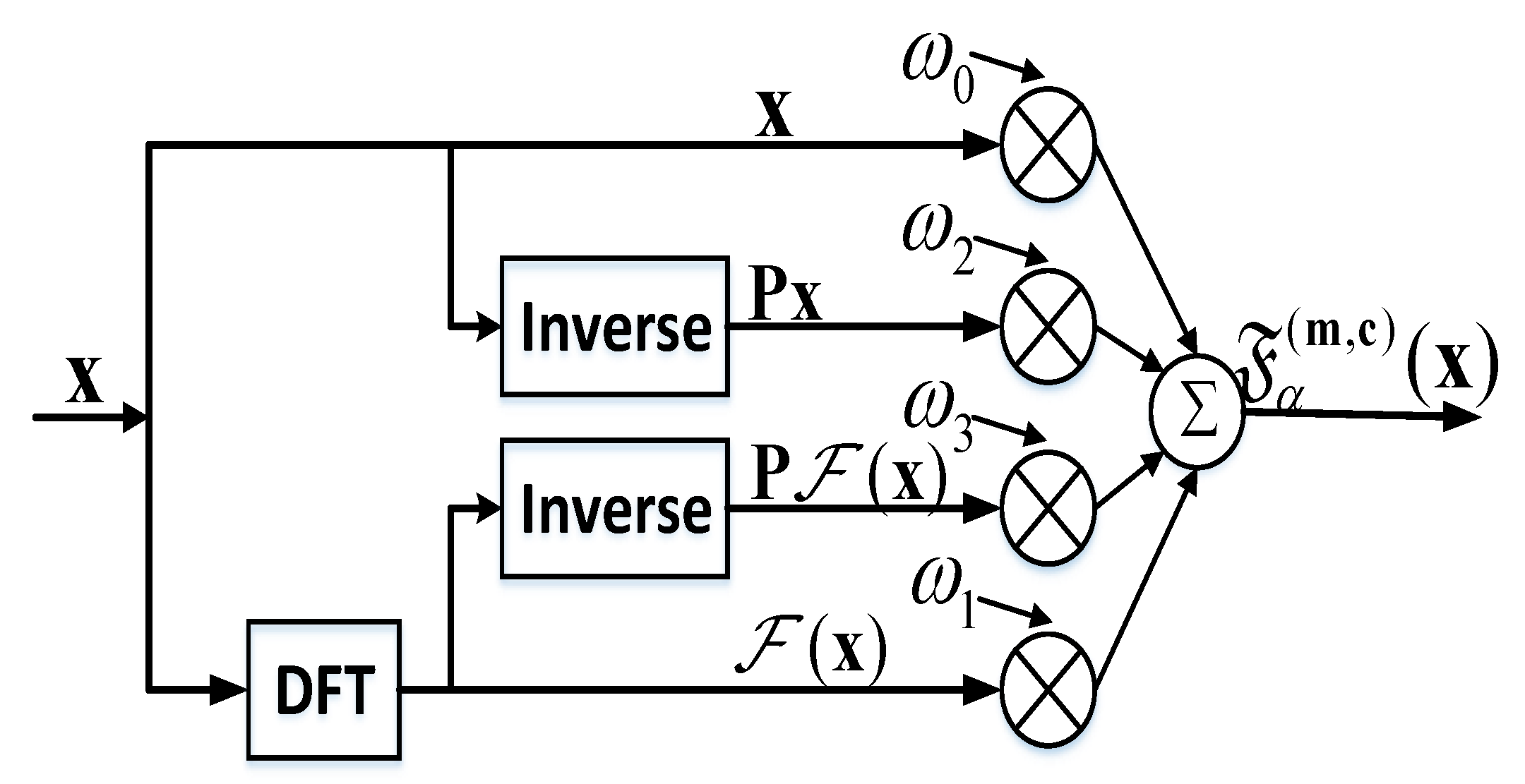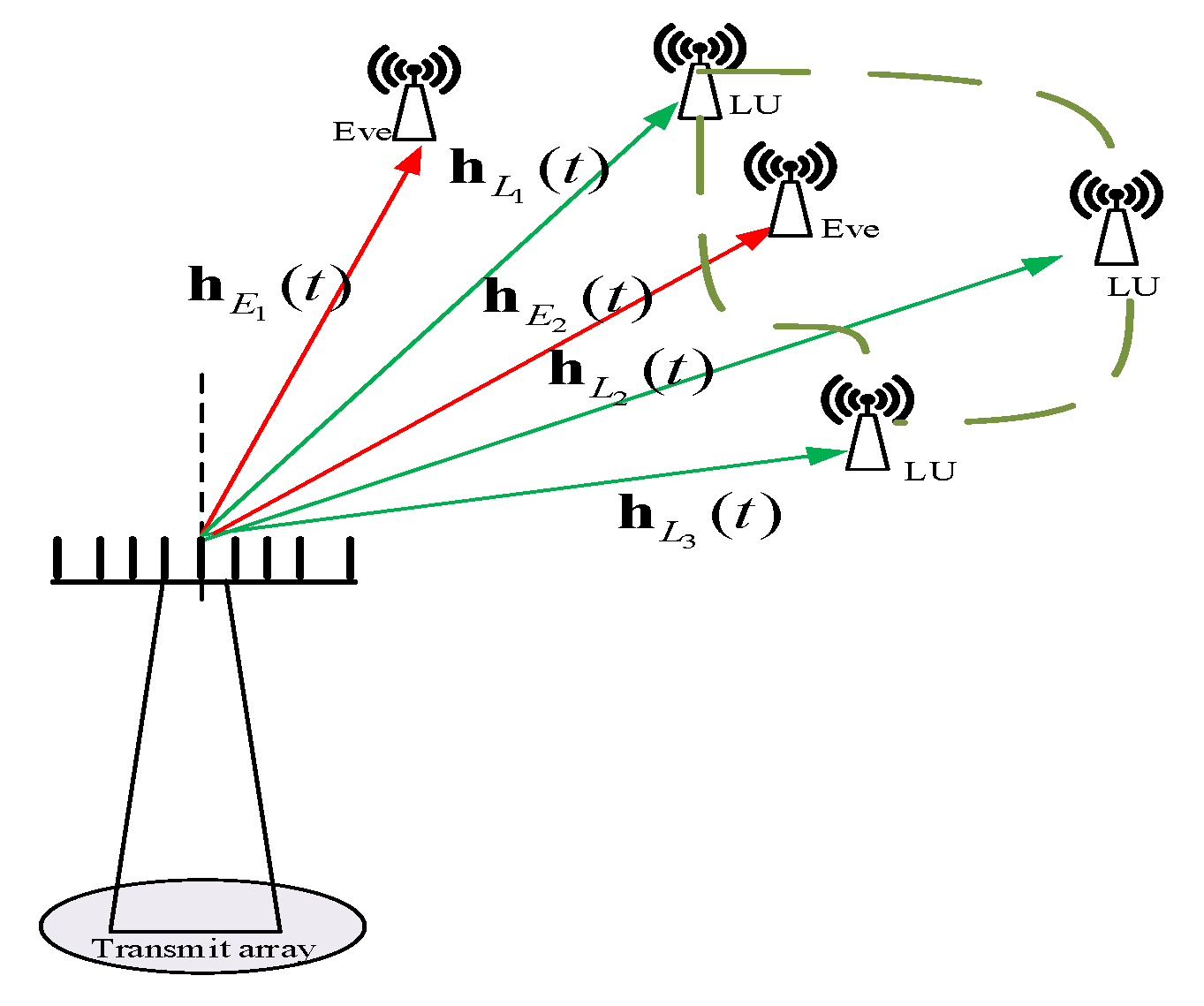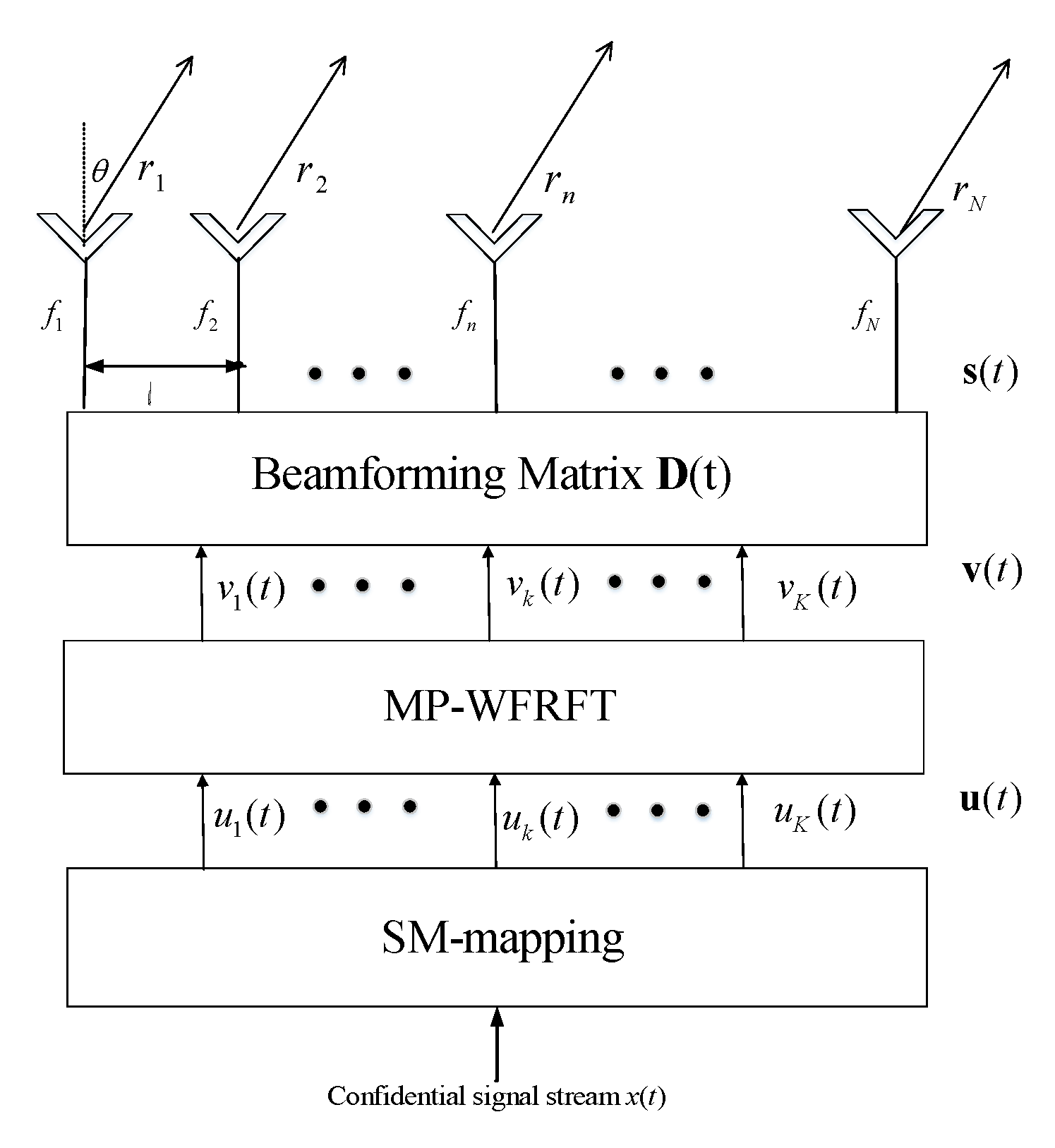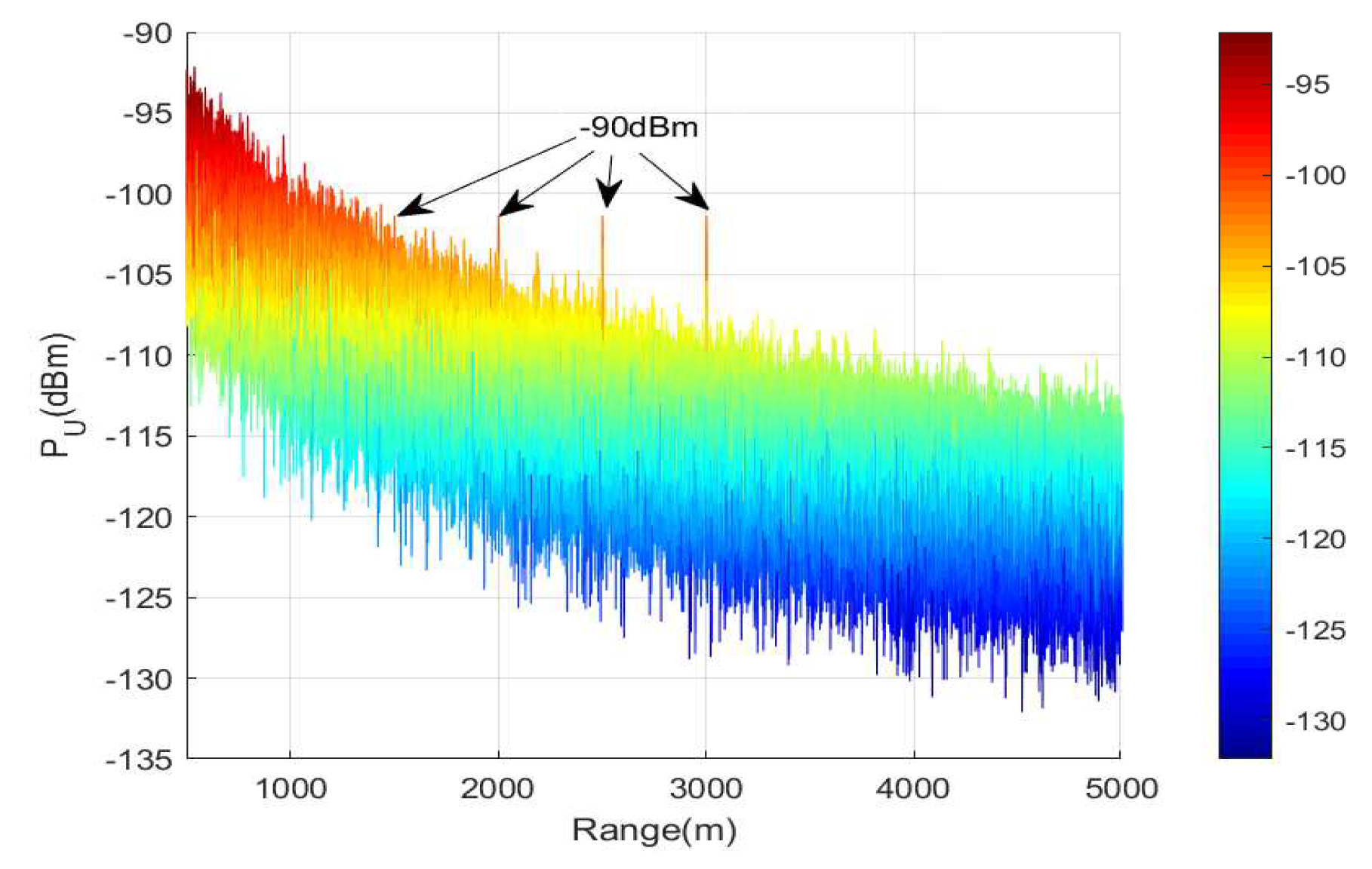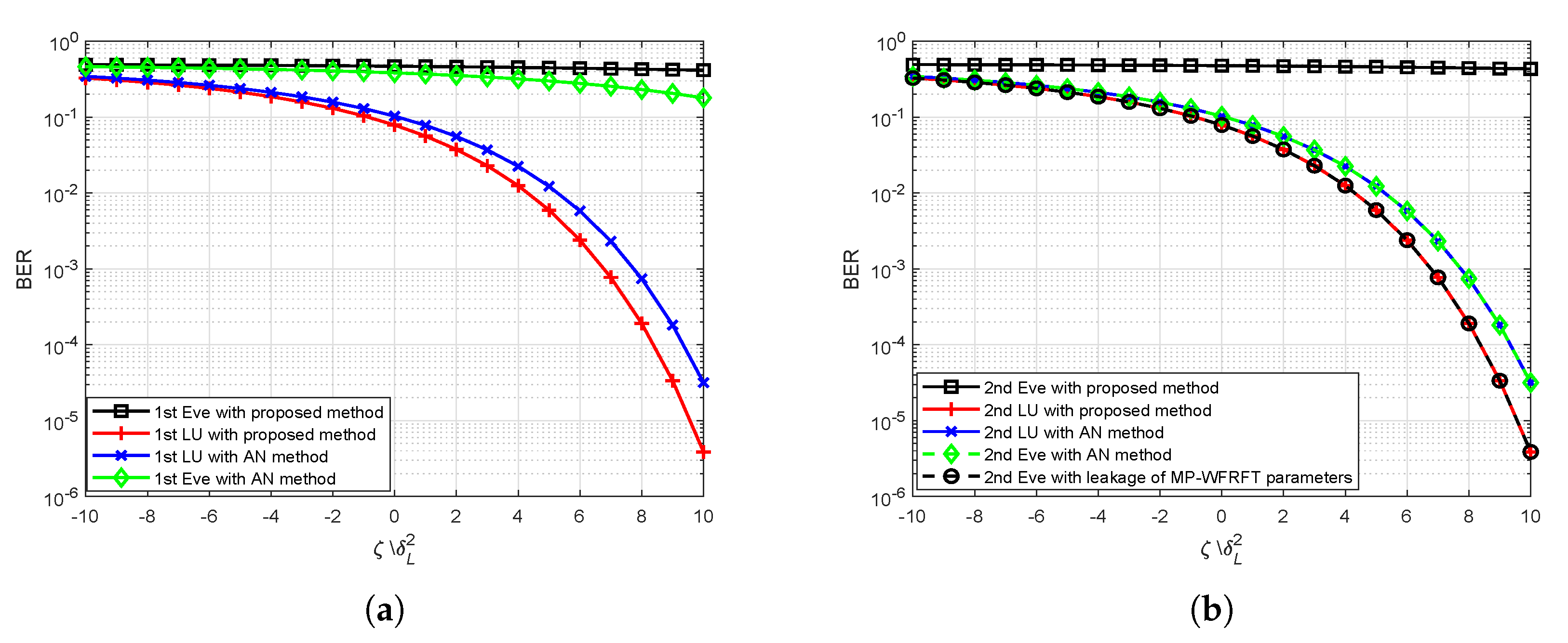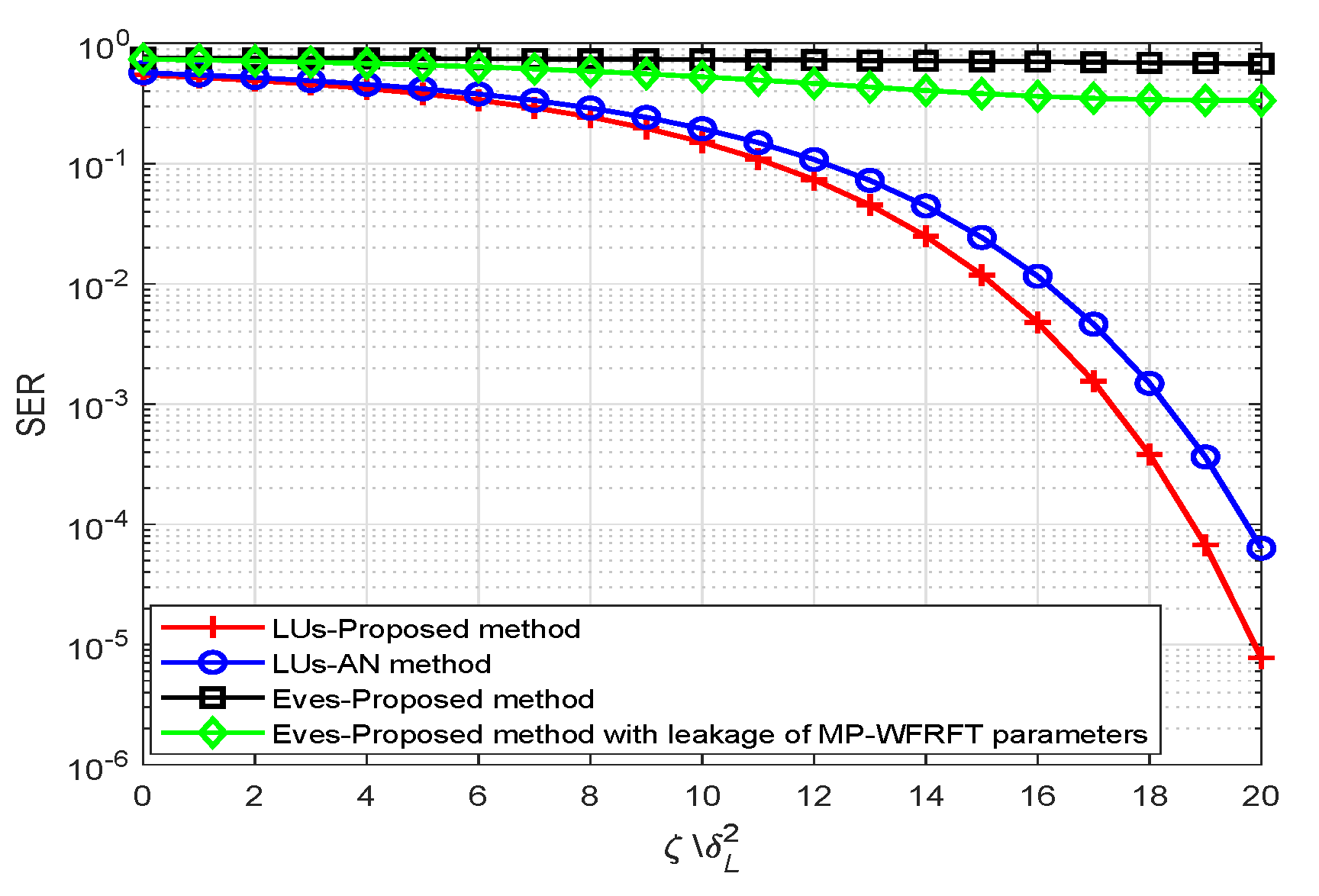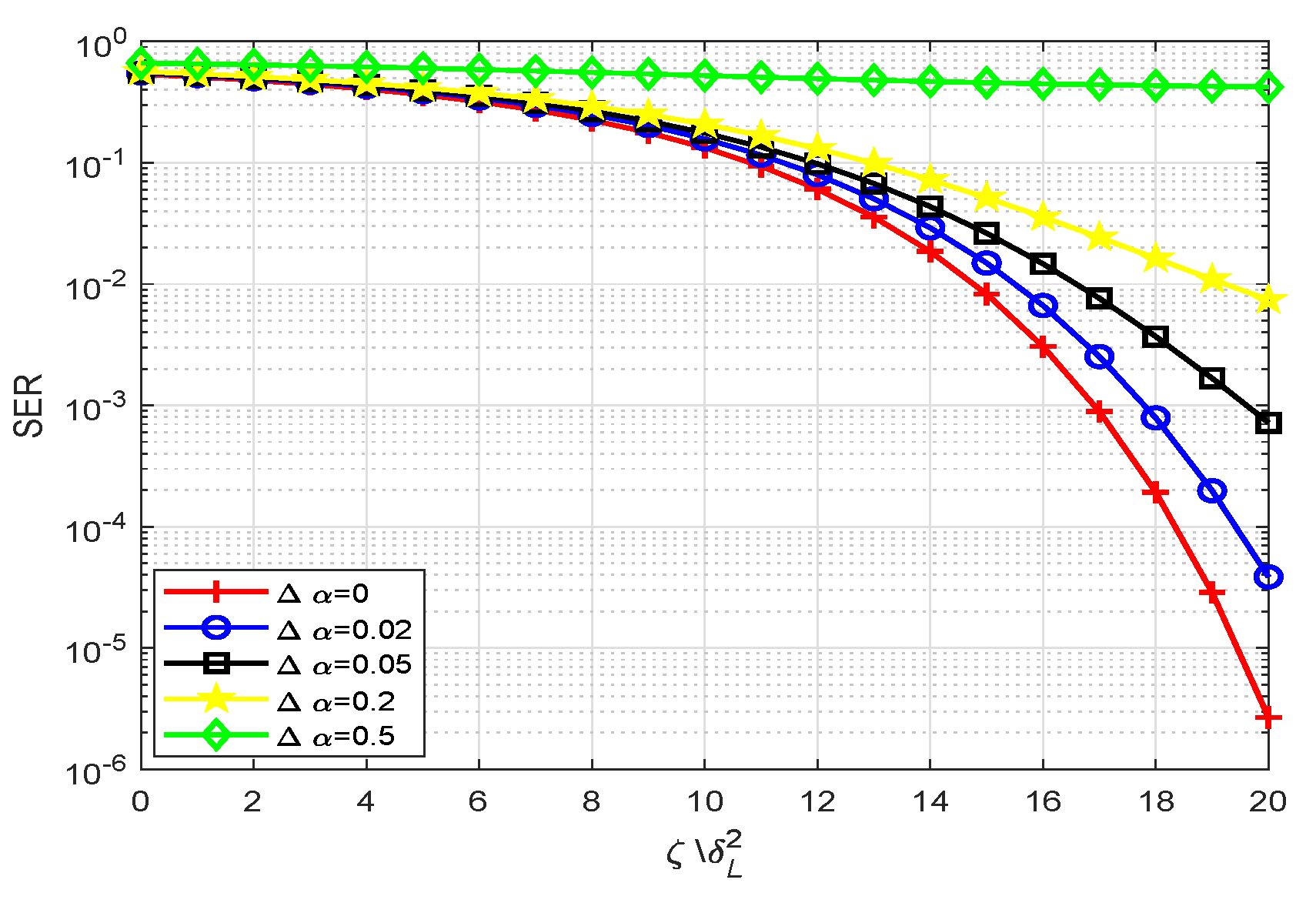1. Introduction
Wireless communication has attracted increasing attention in recent years. However, wireless communication occurs in an open environment and broadcasts information to all users in free space [
1,
2]. Therefore, wireless communication security has become a serious problem in both civil and military fields. Traditionally, upper-layer encryptions technology has been widely used in wired communication. However, encryption systems are inherited from the traditional computer network and ignores the special physical layer characteristics of wireless communication system, such as the openness wireless channel, time-varying network topology, and resource limitation of mobile terminal [
3,
4]. As a result, physical layer (PHY) security was introduced to achieve the confidentiality of messages at the PHY [
5]. PHY security enables wireless communications to exploit the properties of physical layer to scramble information content that could be potentially intercepted by eavesdroppers, while simultaneously delivering it to its desired receivers. DM, as a keyless physical-layer security transmitting technique with great potentials, has attracted a great deal of attention over the past decade. It uses antenna arrays to transmit a signal only along the desired directions while distorting signal constellations in all other directions [
6,
7].
Traditionally, DM technology has been mainly implemented based on phased arrays (PA) in the past decade [
8,
9,
10,
11]. However, the previous communication schemes based on PA can no longer guarantee secure transmission when eavesdroppers locate in the desired direction of LU due to the transmit beampattern being only angle-focusing. Accordingly, it is necessary to investigate other schemes that can prevent eavesdroppers in the desired direction from intercepting messages. Therefore, we depart from PA and apply a frequency diverse array (FDA) into DM implementations because of its extra range dimension dependence, rather than being dependent on only the angle used [
12,
13,
14,
15,
16,
17].
FDA delivers a new opportunity for secure wireless communications. However, the beampattern of FDA is still angle-range coupling, which means that confidential messages are accessible to illegitimate receivers that are located at some angle-range pair curves. Several works have focused on frequency offsets to address the coupling problem of FDA [
18]. To this end, in [
19,
20], the authors proposed a logarithmic frequency increments scheme. Furthermore, with random frequency increments between each element, the author of [
21] proposed a new FDA structure, named random FDA, to indicate targets’ direction and range without coupling. Besides the radio frequency fronted technology, adding AN at the baseband is another effective technology used to deteriorate the received messages of Eves that has been employed in DM systems [
22,
23]. An FDA DM scheme with AN [
24,
25] has been proposed to further improve secrecy performance, and a robust synthesis scheme with AN was proposed in [
26] for a single user scenario.
In summary, the current studies cannot deal with the PHY security problem of multiple receivers obtaining different messages simultaneously, which needs to be addressed in practical applications. The traditional DM schemes with AN need to allocate power to the AN, which will lower the power efficiency of total transmitting power. Furthermore, in practical cases, the Eves would be located as close to LU as possible (even in the same locations as the LUs) to eavesdrop on the confidential signal, and the previous studies have shown that it is difficult to ensure the security of the independent confidential message in this case. In addition, the received power at each LU is not accurately controlled according to the prescribed power.
In order to address the limitations of the previous works and further enhance the PHY security, we proposed a spatial modulation (SM) and multiple parameter weighted-type fractional Fourier transform (WFRFT)-aided scheme based on a random frequency diverse array (RFDA).
WFRFT, as a new transformation domain signal processing method based on Fourier transform [
27], is gradually being applied to the wireless communication systems. WFRFT is actually the process of rotating the signal in the time-frequency plane to realize the time-frequency redistribution of signal power, and only when the users rotate the signal in same angle, but the opposite direction can the signal power be concentrated. Therefore, due to its power redistribution on the time-frequency plane, WFRFT technology can be regarded as a cryptographic method to further improve secrecy performance [
28,
29,
30,
31]. Furthermore, in [
32], a synthesis scheme combining WFRFT and FDA DM was investigated to achieve power efficiency multi-beam secure communication. The contributions to physical layer security were promising. Apart from the above-mentioned WFRFT schemes based on a single parameter, the multiparameter WFRFT synthesis approaches have also been investigated intensively [
33,
34]. The MP-WFRFT system has a good parameter resistance, allowing it to detect in the condition of the eavesdroppers with a known signal transformation mode; in particular, this method can be combined with the existing DM technology, which can further improve the capacity for anti-interception and anti-detection based on the original system confidentiality.
SM, as an emerging information modulation technology, has gradually been introduced into wireless communication in recent years due to its high data rate and spectral efficiency. The basic idea of SM is to use the transmit antenna number as an additional information bearing unit to transmit more information bits than the single modulation symbols. However, in this paper, unlike previous works which applied SM to the multiple-input multiple-output (MIMO) system [
35,
36,
37,
38], the authors use SM technology based on FDA with cooperative LUs in order to avoid high interchannel interference at receivers and complicated estimate algorithms (e.g., maximum likelihood [
35] and MRRC [
38]) are required.
On the basis of the previous work, we propose a spectrally efficient and power-efficient multi-beam security communication scheme with the joint use of multiple techniques including MP-WFRFT, SM, and FDA–DM. Our main contributions can be summarized as follows.
(1) The proposed scheme combining MP-WFRFT realizes the embedding process of “AN” from the modulation level of digital baseband signal. Therefore, the proposed scheme based on MP-WFREFT avoids the power resource waste compared with traditional AN added scheme.
(2) In this paper, we apply SM technology into the FDA system with cooperative LUs, which can transmit additional information bits by using LUs number information compared to single modulation symbols to improve the capacity of communication system. Furthermore, the proposed scheme can ensure communication security when Eves are proximal to LUs or even in same locations.
(3) Unlike conventional beamforming method for multi-beam DM, we design the FDA beamforming matrix based on the minimum transmission messages power rule, which also can accurately control the received power of LUs.
The rest of this paper is organized as follows.
Section 2 provides a review of DM PHY, MP-WFRFT and SM. Then, in
Section 3, we propose the SM- and MP-WFRFT-aided scheme based on FDA. The performance is deduced in
Section 4 and is numerically evaluated in
Section 5. Finally,
Section 6 draws conclusions.
3. SM and MP-WFRFT Aided Scheme Based On FDA
3.1. The Architecture of System with Cooperative LUs
The traditional PA-DM schemes and even the AN-aided PA-DM synthesis schemes cannot achieve range dependence, and so these schemes cannot prevent eavesdroppers from intercepting messages and recognize private users in same direction. Therefore, we depart from PA and apply FDA into our DM implementations because of its extra range dimension dependence rather than simply angle dependence. In this paper, the line-of-sight (LoS) channel, far-field communication, and Gaussian wiretap channel are considered. As shown in
Figure 2, the system consists of a legitimate transmit station,
K LUs whose information can be shared with each other, and
J passive Eves whose locations are unavailable to transmitter station.
A uniform N elements linear array with a spacing d is utilized for the transmitter. The transmitting frequency at the (n = 1, 2, …, N) antenna is designed as , where is the carrier wave frequency and is the frequency increment. Here, we propose RFDA whose beam pattern is angle-range independent without coupling. Therefore, can be replaced as , where refers to a fixed frequency increment, and represents a random variable.
For an arbitrary receiver at
, the normalized steering vector is denoted by
where
c denotes light speed,
refers to the path loss factor due to the free space propagation.
The location of LU
K is
, and for simplicity
is the normalized steering vector of LU
K. Furthermore, we use the steering matrix
to denote steering vectors of all LUs, i.e.,
where
is the instantaneous normalized steering vector of
k-th LU at
.
3.2. The Radiating Signal Processed by SM and MP-WFRFT
The architecture of transmit station is shown in
Figure 3. In this paper, we innovatively apply two key modulation techniques into FDA-DM. Before transmitting the confidential signal to LUs, we first use the SM module for the confidential signal stream
and
is normalized, i.e.,
. Then, we divide the confidential information bit stream into blocks. As mentioned in previous section, each block contains
bits. The SM is operated to the confidential information block, which yields the transmitting symbol vector
where
is the transmitting symbol for the
k-th LU, and
is the SM mapping.
Second, the transmitting symbol vector
is performed by MP-WFRFT with parameters
, which can be expressed as
The vector is rotated in the time-frequency plane to realize the time-frequency redistribution of signal power. Therefore, only when the users rotates the signal in same angle but the opposite direction can the signal power be concentrated.
Before radiating, we design the beamforming matrix
to further process the symbol vector
to match all transmit antennas. The beamforming matrix
is given by
where
, for
, is the beamforming vector to process symbol
that is transmitted to
k-th LU.
In order to obtain the beamforming matrix
, the locations of LUs are assumed to be previously known by transmit station, i.e., the steering matrix
is known in advance. Next, we design the beamforming matrix
based on the rules that (1) the intended LU effectively receives the corresponding confidential messages, while the undesired LUs cannot obtain the messages, and (2) the transmit power is minimum, while satisfying communication performance requirements of each LU. Therefore, the beamforming matrix
is designed by
where
, in which
, and
is the minimum desired power, for
.
According to the pseudo-inverse concept, we obtain
as
After processed by the beamforming matrix, the radiating signal for the
N antennas is given by
3.3. The Received Signal of LUs and Eves
The receiving structure with cooperative LUs is shown in
Figure 4. Because of cooperative LUs, we combine all LUs received signals together as an LUs received vector, i.e.,
. In this paper, assuming that (1) the synchronization of time and frequency is perfect in the ideal scenario, and (2) the MP-WFRFT parameters are securely shared between the transmit station and LUs. As shown in
Figure 4, the received symbol is first operated by inverse MP-WFRFT with
, which yields
where the shared parameters
. Based on (9), (11), and (13), (14) can be further simplified as
where
is the AWGN vector with each element having zero mean and variance
, i.e.,
.
is the AWGN vector after MP-WFRFT, which remains the same distribution characteristics, i.e.,
. Thereinto, the received symbol of
k-th LU is given by
From (15) and (16), it can be seen that each LU can effectively receive the corresponding transmitting symbol under the control of desired received power, and the transmitting symbol vector is recovered via inverse MP-WFRFT with cooperative LUs. Then, after the correct reception and inverse MP-WFRFT of all LUs, the confidential signal stream x(t) is obtained by demapping the transmitting symbol vector .
Next, we assume there are
J passive Eves located in different positions intercepting the confidential information. We define
as the coordinates of Eve
j and use the steering matrix
to denote steering vectors of all Eves, i.e.,
where
is the instantaneous normalized steering vector of
j-th Eve. Furthermore, we consider a worse case in which Eves in different positions can cooperate with each other. Similarly, the received message of Eves is given by
where
, and
is the AWGN vector with each element having zero mean and variance
, i.e.,
. Specifically, the received signal of
j-th Eve intercepting
k-th LU’s information is given by
according to the first part of (18), the amplitude and phase of the received symbol is distorted by MP-WFRFT operations
and the item
. The second part of (18) mainly shows interference from other messages, and the third part is the equivalent AN as the process of rotating the signal in the time-frequency plane due to MP-WFRFT. The last part is AWGN. Our proposed scheme does not add noise into the baseband signal, but the application of MP-WFRFT in our proposed method also can achieve an equivalent noise effect on Eves, which means it uses less power compared to conventional AN-DM schemes.
On the other hand, MP-WFRFT technology is dependent on the assumption that the MP-WFRFT parameters are unknown for Eves. Once the MP-WFRFT parameters are leaked to Eves, Eves will demodulate their received signals via inverse MP-WFRFT operation. However, in this paper, we use another SM technique based on FDA with cooperative LUs. After the use of the SM and MP-WFRFT aided multi-beam FDA scheme, it is hard for Eves to wiretap the confidential messages. The Eves can correctly recover the confidential messages, only when estimates of LUs number information, the MP-WFRFT parameters and the corresponding symbols are all correct. Furthermore, even if one or some (but not all) of the Eves’ locations are same as one or some LUs’ locations and MP-WFRFT parameters are leaked to all Eves, our proposed scheme can also ensure the security wireless communication due to the use of SM technique with cooperative LUs. Therefore, our proposed method is able to degrade Eves’ reception and improve transmission security. Furthermore, our proposed method can achieve power efficient due to MP-WFRFT technology and information bits efficient by use of LUs number information as another information carrying unit in addition to constellation diagram.
4. Performance Analysis
With the basic knowledge of the SM and MP-WFRFT aided RFDA-DM scheme, we next analyze the secrecy performance of the system through the symbol error rate (SER) and bit error rate (BER), which are important metrics to measure the performance of wireless communication systems. Moreover, we analyze the anti-interception performance and provide comparisons with different DM schemes.
4.1. Symbol Error Rate
The confidential messages can be recovered only when estimates of MP-WFRFT parameters, the number information of LUs, and the corresponding modulation symbols are all correct. Here, we consider that the MP-WFRFT parameters are securely shared between transmitter station and LUs. Therefore, in order to calculate the overall SER
, we should consider the probability of error
for the estimates of number information and the SER
of corresponding modulation symbols. The overall SER
can be calculated as
First, the
of corresponding modulation symbols is calculated. Only BPSK modulation, i.e.,
, is considered throughout this paper. Moreover, the number of active LU is
. The theoretical SER
over AWGN channel can be obtained by
where
is the complementary error function.
is the signal to interference-plus-noise ratio (SINR). According to Equation (
16), we can calculate the
of LU
k as
According to the Equations (10), (11), and (12), the total transmit power
can be calculated as
By contrast, with the conventional AN-DM shceme, we need allocate power to AN to suppress the signal received by Eve. Therefore, the transmit power of confidential message can be expressed as
, and the SINR
of LU
k can be obtained by
where
is the power splitting coefficient for confidential messages.
According to the Equation (
19), we can calculate the
of
j-th Eve intercepting
k-th LU’s information as
Next, the probability error
at LUs and Eves is calculated, respectively. Here, we consider the probability error
for the LUs. In this paper, we assume that the LUs know the SM mapping in advance and that Eves cannot wiretap any SM information. Meanwhile, each independent LU effectively receives the confidential signal, which is verified in the next subsection. Therefore, we consider a reasonable approximation
at LUs. Then, we calculate
at Eves. Due to the arbitrary locations, Eves cannot wiretap any number information. Therefore,
at Eves can be obtained by
4.2. Anti-Interception Performance
In this subsection, the anti-interception performance of the proposed MP-WFRFT- and SM-aided DM scheme is investigated. We assume the LUs know the SM mapping in advance and Eves cannot wiretap any number information. However, before performing the proposed scheme, we also need to exchange the MP-WFRFT parameters between the transmitter station and the LUs through a secure channel. In a practical application scenario, the Eve may know the MP-WFRFT modulation and intercept them with imperfect parameters. Therefore, it is necessary to analyze the effect of the leakage of MP-WFRFT parameters on the secrecy performance of our proposed scheme. Here, the actual MP-WFRFT parameters can be expressed as
where
, and
are the mismatched errors. The detailed simulations and analysis are given in
Section 5 for investigating the impact of these nine MP-WFRFT mismatched parameters on secrecy performance.
4.3. Discussion
In this section, we present a comparison with some previous works in
Table 2, which fully compares different schemes from different aspects of power efficient (PE), neighbor security (the location of Eve is close to or the same as that of LU, NS), control of received power (CR), range-angle security (RA), and spectral efficiency (SE).
From
Table 2, we generalize the advantages of our proposed scheme as follows.
(1) Compared with PA-based DM schemes, the proposed scheme can achieve the range-angle security due to the FDA characteristics.
(2) The high overall spectral efficiency. The idea of SM is to map a block of information bits to symbols that are chosen from the constellation diagram and numbers information of LUs that are chosen from the sets of LUs. The numbers information of multiple LUs can be directly used as additional sources to transmit information simultaneously.
(3) Compared with AN-aided DM schemes, our proposed scheme is power efficient due to MP-WFRFT technique which realizes the embedding process of “AN” from the modulation level of digital baseband signal.
(4) Our proposed scheme can guarantee security of confidential message in some challenging application scenarios. Based on conventional DM schemes, as long as an Eve is close enough to the LU, the confidential messages can be intercepted by the Eve due to constraint on beamwidth. To illustrate the advantage of the proposed schemes, we consider the worst case where Eves know the MP-WFRFT operation with perfect parameters, and these Eves with same number of LUs can cooperate with each other. Therefore, the received symbol vectors of Eves are first operated by the inverse MP-WFRFT with the shared parameters
, which yields
Here, we assume Eves know the MP-WFRFT operation with perfect parameters, which means
Then the (35) can be further written as
Specifically, the received signal of
Eve intercepting
LU’s information can be obtained by
From (38), in the worst case, we can see that WFRFT operation cannot achieve encryption security. When the Eve’s location is the same as the LUs—i.e., , , —the AN–DM scheme and WFRFT-aided DM scheme both fail. However, based on our proposed scheme, it is also difficult for Eves to wiretap confidential messages, as estimates of the index information of LUs also need to be correct. Moreover, even if one or some (but not all) of the Eves’ locations are same as one or some LUs’ locations, the confidential messages are still difficult to retrieve for Eves. Therefore, our proposed method achieves better anti-interception performance and thus improves transmission security.
